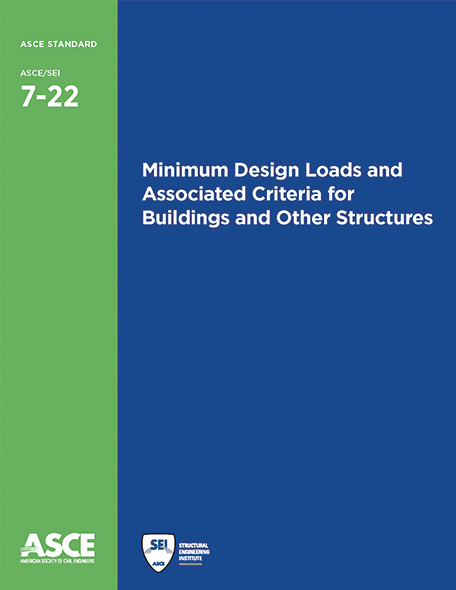This quarterly article addresses some of the questions received about structural standards developed by the Structural Engineering Institute (SEI) of the American Society of Civil Engineers (ASCE). In addition, questions from engineers, building officials, and other design professionals are often considered to develop future editions. Following are some questions received by SEI and responses to clarify the provisions.
Supplements Include Critical Revisions
ASCE 7-22 was published in December of 2022, but I heard there is a supplement to update the referenced standards. Why is there a supplement, and where can I find it?

The publication of a supplement is a formal process to provide additional consensus provisions to the edition of the standard already published. This frequently happens following the completion of a cycle to address coordination issues that were not possible to address during the standard development cycle. Another reason for a supplement is to update references that are not yet complete to a point where they can be incorporated at the time of publication. In the case of ASCE 7-22, the committee developed two supplements. The first one, Supplement #1, (March 21, 2023), includes several updates to referenced standards to bring in the most current editions. Additionally, a few coordination items were included in the supplement. The affected chapters include Chapter 6, Tsunami Loads and Effects, Chapter 14, Chapter 15, Chapter 23, Chapter 26, and Chapter 29; additionally, the provisions in the commentaries were updated in Chapters C6, C12, C13, C14, C15, C26, C29, and C30.
The provisions in Supplement #2 (May 25, 2023) include a complete rewrite of Chapter 5, Flood Loads. This revision also includes flood load-related changes to Chapter 1 and Chapter 2.
Supplements #1 and #2 were completed after the ASCE 7-22 adoption into the I-Codes. Therefore, both will be brought forward into the next code adoption cycle for the 2027 I-Codes. Both supplements can be found at asce.org/asce7.
Updates to Chapter 5 in ASCE 7
What is the scope of ASCE 7-22 Supplement #2? It only includes Chapter 5, Flood Loads, so how do I use it?
The scope of the supplement includes the revisions and updates to Chapter 5, Flood Loads. As part of the update, Section 1.3.1.3 and Sections 2.2, 2.3.2, and 2.4.2 are also included for completeness. As published in Section 5.1 of Chapter 5, The provisions of this chapter apply to buildings and other structures located in a Flood Hazard Area. This chapter shall not apply to the design of levees, dikes, piers, wharves, roads, or bridges.
As a supplement to the published 2022 edition, the document was published after the base document was adopted into the 2024 International Building Code (IBC), therefore the supplement will be proposed for adoption into the 2027 IBC. The supplement is published in the ASCE Library and available as a free download at asce.org/asce7.
Designing for the 500-year Floodplain
How does the ASCE 7-22 Supplement #2 use the 500-year floodplain? How is this different from the 7-16 provisions?
The Supplement uses a new design approach! The requirements of Section 5.3 tie flood hazard mitigation design to Risk Category, consistent with other environmental hazards in ASCE 7 and different from the 2016 provisions.
Furthermore, the 500-year floodplain now defines the Flood Hazard Area and applies to all risk categories except for Risk Category I; see the language below.
5.3.1 Flood Hazard Area – For Risk Categories II, III, and IV structures, the Flood Hazard Area shall be the 500-year floodplain designated as the Special Flood Hazard Area and the Shaded X-Zone. For Risk Category I structures, the Flood Hazard Area shall be the 100-year floodplain designated as the Special Flood Hazard Area.
Relative Sea Level Change
Does the ASCE 7-22 Supplement #2 require any impacts from relative sea level rise?
Yes! It is clearly stated in Section 5.3.4. The effects of relative sea level change shall be included in calculating flood conditions and flood loads for sites whose flooding comes from coastal sources. The section also defines that the project lifecycle of not less than 50 years shall be used and that, at a minimum, the rate of relative sea level change shall be the historically recorded sea level change rate for the site over a 50-year period.
This article’s information is provided for general informational purposes only and is not intended in any fashion to be a substitute for professional consultation. Information provided does not constitute a formal interpretation of the standard. Under no circumstances does ASCE/SEI, its affiliates, officers, directors, employees, or volunteers warrant the completeness, accuracy, or relevancy of any information or advice provided herein or its usefulness for any particular purpose. ASCE/SEI, its affiliates, officers, directors, employees, and volunteers expressly disclaim any and all responsibility for any liability, loss, or damage that you may cause or incur in reliance on any information or advice provided herein.
If you have a question you want to be considered in a future issue, please send it to sei@asce.org with FAQ in the subject line. Visit asce.org/sei to learn more about ASCE/SEI Standards.
